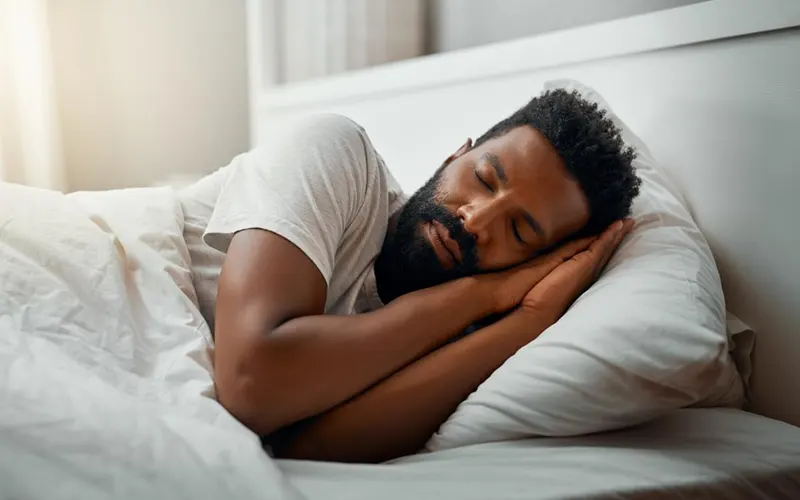We all have a go-to way of sleeping, the position we naturally settle into after a tiring day. What’s yours? Mine is on my stomach (I know, not the best), but I usually end up on my right side because my French Bulldog is snuggled up on that side, snoring away.
Choosing how we sleep is a personal preference, but it’s more than just that. Our sleep positions can impact our bodies in various ways. Consider this: you spend about one-third of your life sleeping, which means a significant amount of time is spent in a few specific sleep postures. These positions can affect the quality and quantity of our sleep, influencing our overall health. Research even suggests that sleep position can affect our dreams and is connected to our personality!
Continue reading to discover how your sleep position may be impacting your health and sleep quality, and what it might reveal about your personality and dreams.
It’s generally best to stick with what feels most comfortable, as long as it doesn’t cause any pain, especially in your back or neck.
Elements influencing the way we sleep
When considering sleep positions, comfort is typically the foremost factor that springs to mind. Our preferences for sleep positions are unique to each individual. While sleeping on your stomach might feel cramped to you, your bed partner may find it incredibly comfortable. Similarly, the curled-up fetal sleep posture that feels just right for you might make your bed partner feel confined and rigid.
While comfort is a crucial factor, it’s not the sole consideration. There are additional, sometimes less noticeable factors that play a role in the sleep positions we gravitate toward.
The Impact of Age on Sleep Positions
As we grow older, many of us tend to favor sleeping on our sides. Research indicates that the preference for side sleeping typically starts in early adulthood and becomes more prominent with age. Studies specifically highlight a tendency for right-side sleeping in older adults. While there are suggestions that this preference may contribute to protecting heart function during sleep, scientists have not confirmed this explanation yet.
With age, there’s also a decrease in nighttime movement, leading to less frequent shifts in sleeping positions. Research reveals that children change their sleep positions more than twice as often as adults over 65. Anyone who has shared a bed with a child can attest to this truth!
In general, sleep position becomes more significant as we age. Older adults face various health challenges, including those related to sleep. Aging bodies are less flexible, more prone to stiffness and discomfort. While you might not have given much thought to your sleep position in your 20s, as you reach your 40s or 50s and beyond, how you sleep can significantly impact the comfort and quality of your sleep.
Sleep Preferences Based on Gender
Just like various other aspects of sleep, men and women exhibit distinct preferences and needs when it comes to sleep positions. Studies indicate that women are twice as likely to favor the fetal position compared to men.
For women, the choice of sleep position becomes especially crucial during pregnancy. It is advised that pregnant women avoid sleeping on their backs and, instead, adopt a side sleeping position. The American Pregnancy Association recommends the left-side sleeping position for pregnant women. Sleeping on the left side during pregnancy enhances blood and nutrient flow to the placenta. Sleeping on the back during pregnancy can lead to back pain, breathing difficulties, and heartburn. Additionally, a back sleep position may lower blood pressure and reduce circulation in pregnant women.
As you continue reading, you’ll discover a variety of health factors that play a role in determining the most suitable sleep position for each individual.
Sleep Position, Personality, and Dreams
Exploring the relationship between sleep position, personality, and dreams is a fascinating and entertaining aspect of science. While there isn’t an extensive body of research on this subject, certain scientists and body language experts have delved into the connections between how we sleep and our individual personalities. According to their findings, our sleep position can offer valuable insights into our character, mood, and overall approach to life.
The way we sleep can offer intriguing insights into our personalities. Back sleepers, associated with self-confidence, may also exhibit stubbornness and high expectations for themselves and others. The position of the arms, whether down at the sides (indicating reservedness) or outstretched (suggesting a relaxed and open-minded demeanor), can further influence these traits.
On the other hand, stomach sleepers may be linked to defensiveness, perfectionism, and sensitivity to criticism. Researchers suggest that those who prefer sleeping on their stomachs may feel overwhelmed and perceive a lack of control in their lives.
Side sleeping, a popular choice, is correlated with being relaxed, open-minded, and capable of compromise. The specific side chosen, right or left, as well as the position of the arms, can also play a role in shaping one’s personality, outlook, and behavior.
Those who sleep in a fetal position are associated with sensitivity and anxiety, with a desire for comfort. Fetal position sleepers may exhibit conscientiousness and organizational skills, often overthinking situations. While initially reserved, research suggests they possess a warm-hearted nature beneath the surface.
Dreams, too, may be influenced by sleep position. Right-side sleepers may experience fewer nightmares compared to left-side sleepers. Back sleepers may be more prone to nightmares and may find it challenging to recall their dreams. Stomach sleepers, according to studies, encounter more vivid, intense, and sexual dreams. They are also more likely to dream of being immobilized or restrained. If side sleepers experience disturbing dreams, switching sides may be worth considering based on research correlations.
The Advantages and Disadvantages of Common Sleep Positions
Identifying your preferred sleep position is crucial, and there isn’t a one-size-fits-all answer. Beyond comfort, the ideal sleep position varies based on individual health conditions and concerns.
Sleeping on Your Back
Though not widely popular—only about 8 percent of sleepers opt for this pose, according to the National Sleep Foundation—sleeping on your back is an optimal position for many. This position allows the body to naturally align, distributing weight evenly and avoiding undue pressure on specific points. Consequently, sleeping on the back typically requires minimal readjustment throughout the night, contributing to a more restful and refreshing sleep experience.
Opting for back sleeping is often the best choice if you experience physical pain or stiffness. Individuals with arthritis frequently find that sleeping on their backs offers a more sound and comfortable night’s sleep. However, exceptions exist, as back pain can make this position uncomfortable, and certain types of neck pain may be exacerbated by back sleeping. To manage pain effectively, it’s essential to experiment with different positions to discover what provides the most comfort and relief from tension. The Arthritis Foundation offers valuable sleep tips for those dealing with arthritis pain.
Back sleeping can also alleviate nighttime symptoms of GERD or acid reflux, provided the esophagus is elevated higher than the stomach—a supportive pillow can assist in achieving this. If you’re concerned about wrinkles and signs of aging, back sleeping is advantageous as it prevents facial compression against the pillow, reducing the likelihood of lines and wrinkles and potentially minimizing acne breakouts.
However, back sleeping is not advisable for individuals who snore or have obstructive sleep apnea. It can exacerbate snoring and increase the likelihood of airway collapse, leading to more frequent apnea episodes. People with these conditions are better off sleeping on their sides or stomachs. For those with obstructive sleep apnea, avoiding back sleeping has been shown to reduce blood pressure.
Sleeping on Your Side
Moving on to side sleeping, this is a popular and generally healthy sleep position, often considered the second most optimal after back sleeping. For individuals dealing with snoring or sleep apnea, switching to a side sleeping position can help alleviate symptoms, promoting better rest for both the individual and their bed partner. Side sleeping is also beneficial in reducing back and neck pain. If you suffer from carpal tunnel syndrome, side sleeping may be particularly suitable, emphasizing the importance of protecting your wrists from pressure during sleep.
The Impact of Sleep Positions on Health
Choosing a sleep position is more than a matter of comfort; it can significantly affect various aspects of your health. Sleeping on your side seems to enhance the brain’s lymphatic system’s ability to clear waste effectively, crucial for guarding against neurodegenerative diseases like Alzheimer’s, Parkinson’s, and dementia.
The side you choose matters too. Left side sleeping can alleviate acid reflux, aid circulation for pregnant women, and support digestion. Research suggests that right-side sleeping may reduce nervous system activity, lowering heart rate and blood pressure. Some experts believe the preference for right-side sleeping, especially in older individuals, is an instinctive protective response for the heart.
However, side sleeping has its downsides. It may lead to more wrinkles due to facial pressure and disrupt arm circulation, causing discomfort. Side sleepers also tend to shift positions more frequently during the night, potentially resulting in less restful sleep.
The fetal position, a variation of side sleeping, is a popular choice, particularly among women. It shares benefits with side sleeping, including reduced snoring and back pressure. Yet, it can lead to stiffness and restricted breathing if curled too tightly. Using a body pillow can help maintain a more comfortable position.
On the other hand, stomach sleeping, chosen by only 7 percent of sleepers, is generally considered the least favorable option. While it may reduce snoring and sleep apnea in some cases, it often leads to back and neck pain due to the strain on the spine. The unnatural curve in the spine and face pressure can contribute to discomfort and accelerate signs of aging.
Ultimately, the right sleep position depends on your comfort and the highest quality of rest, considering your specific health concerns. If you find yourself restless, experimenting with different postures may improve your nightly sleep.









